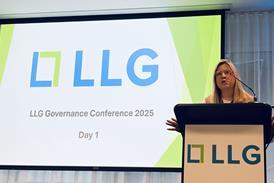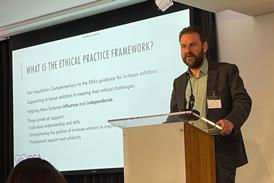Land Registry’s title decider
I am a non-practising solicitor, having been in practice between 1981 and 2020 (I now live in Menorca and am engaged internationally in motorsport ‘law’).
I have read the Gazette reports on systemic change relating to digital conveyancing with interest, especially as I am aware of friends and family experiencing several issues since 2020.
One key area where the proposed digital framework will not succeed without further changes is the position regarding Land Registry filed plans and the Land Registry’s accuracy disclaimer – allied to accurate depiction of boundaries within transfer documents and liability for those boundaries.
In most transfers undertaken diligently, it is necessary to obtain and carefully consider and report on ‘root of title’ documents (or even beyond). Even then, the boundary liability issue often remains unclear. Yet boundary ‘disputes’ are a stressful, vexing, time-consuming and very costly form of litigation (with professional negligence overtones). The title documents may be, and often are, wholly inadequate in this regard, leading to assumptions being made.
In practice, I invariably undertook a physical examination of the purchase site in particular and never failed to discover some issue or other. Sometimes potential disaster awaited (especially in commercial land transactions). I seem to recall a reported case a long time ago which, in essence, said the conveyancer was prima facie negligent if they did not inspect. Conveyancing costs should factor in such matters.
Linked to the above are the inherent and costly delays in resolving such land/boundary disputes, with differential ‘jurisdictions’ between Land Registry/Lands Tribunal processes and civil courts. Such matters need a single point of resolution (a dedicated property court with an experienced senior property lawyer sitting with an expert surveyor, perhaps). This should operate on a very fast-track determination basis, with severe costs penalties for those who act ‘unreasonably’.
Thanks for delivering a very readable Gazette – even to a semi-retired.
Jamie Champkin
Menorca
How about a mentoring scheme for legal aid?
I’ve just read your piece about the Legal Education and Access Programme, a mentoring scheme for university students from disadvantaged backgrounds.
While I can see what Jude D’Alesio is trying to do, the focus seems to be on assuring entry into the corporate legal sector.
I am aware also of the various initiatives corporate firms have introduced to encourage diversity. They have huge resources that enable them to do so.
I have worked in the legal aid sector since 1990. I had a short stint running my own small firm doing private work. That business model assisted those outside the scope of legal aid or who had been excluded from it because of LASPO.
The issues faced by the legal aid sector are serious. We have whole areas in the UK where there is simply no provision of legal aid or, where there is, solicitors struggle to cope with workloads.
Another issue is recruitment. I sense a real fall in interest and therefore applications. I do not feel there are aspiring lawyers behind me who will take over. The nature of the work and low salaries mean it is now very difficult for anyone to think about a career in legal aid. Corporate firms have their pro bono units and offer out their trainees as support, but ultimately what will become of the legal aid sector?
I do not see large numbers of people who want mentoring to come into this sector. We need something to shift here – and quickly.
As a student on the then Law Society Finals course in 1989, most of my fellow students went to the City. A handful of us went into legal aid work. There was a small handwritten note by a previous student on the noticeboard with the names of the legal aid firms to which one could apply.
It’s 2025 and I can still see that note. How many students now would even look at it?
Access to justice is at risk. Mentoring schemes which provide for access to the corporate world must also serve our sector of the profession.
Smita Bajaria
London
Prenup clarity
Your Taylor Swift correspondent, Monidipa Fouzder, writes ably about prenuptial agreements, ‘Will Taylor Swift and Travis Kelce sign a prenup?’, particularly in view of the Law Commission’s recommendations of 2024 and, indeed, earlier. In fact, in its 2014 project, ‘Matrimonial property, needs and agreements’, it proposed what became known as ‘QNups’ or qualifying nuptial agreements.
Neither should we should ignore this July’s Court of Appeal judgment which is crucial to those who are contemplating a prenup, or even a postnup. The Court of Appeal in Helliwell v Entwistle overturned a case where the prenuptial agreement had left the wife with £66m and the husband with £400,000. It emphasised that disclosure is not simply a gold standard in circumstances where the parties have signed a binding agreement, expressly stating that full and frank disclosure has been provided.
Regardless of any change to the law advocated by the Law Commission, we are now clearer on how to advise our clients if they want to have a prenup upheld.
Tony Roe
Family law partner, Dexter Montague, Reading
Wrong address
Congratulations to the Law Society for catching up with ‘woke-ism’ by thinking it necessary to deplore the use of ‘Dear Sirs’ in correspondence – as if solicitors are unable to think for themselves as to what is the appropriate way to address their recipients.
Surely there are more important ‘diversity and inclusion’ aspects worthy of the attention which has been given to this unnecessary guidance from Chancery Lane.
David McIntosh
President of the Law Society 2001/02, Hove































No comments yet